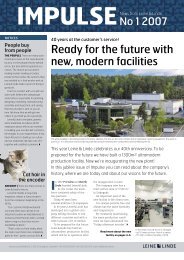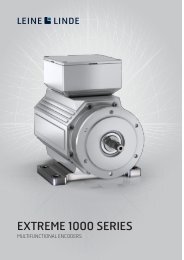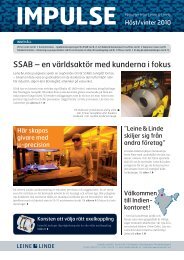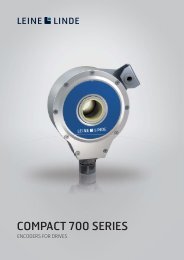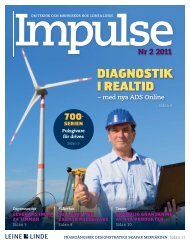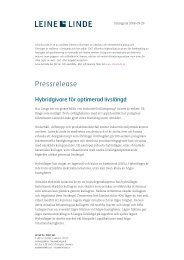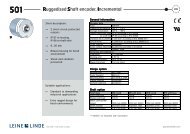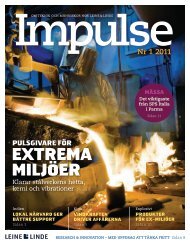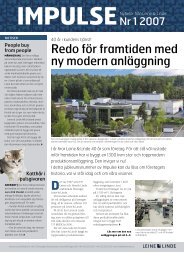Impulse no. 1 – 2010 (PDF) - Leine & Linde
Impulse no. 1 – 2010 (PDF) - Leine & Linde
Impulse no. 1 – 2010 (PDF) - Leine & Linde
Create successful ePaper yourself
Turn your PDF publications into a flip-book with our unique Google optimized e-Paper software.
TECHNICAL INFORMATION<br />
Handling pulse encoder cables<br />
When a pulse encoder is installed, attention must be paid to the fact that the<br />
connection cables can only tolerate a certain level of stress. The cable specifications<br />
must always match the requirements of the application. Cheap cables<br />
often reduce system function and are seldom a good investment in the long run.<br />
If cables are pulled, coiled, bent or subjected<br />
to pressure they can be damaged.<br />
Cables subjected to this kind of impact<br />
should always be replaced.<br />
<strong>Leine</strong> & <strong>Linde</strong> recommends that connection<br />
cables for pulse encoders always<br />
be laid in a separate cable duct. In combination<br />
with other measures, this improves<br />
the EMC properties for the entire<br />
installation. If there is only one combined<br />
cable duct available for signal and power<br />
cables, the signal cables should be bundled<br />
together and positioned as far away<br />
as possible from power cables. There are<br />
several advantages to separation:<br />
Better EMC properties<br />
Better protection from damage, for<br />
example if bigger power cables are laid<br />
in the same duct at a later point<br />
Simpler fault tracing during maintenance.<br />
If despite everything there is disturbance<br />
from surrounding equipment, <strong>Leine</strong> &<br />
<strong>Linde</strong>’s Optolink solution can always be<br />
used. Transmitting pulse encoder signals<br />
via an optical fibre cable eliminates the<br />
risk of disturbance.<br />
Unused cables in multiconductor<br />
Cable conductors should always be<br />
regarded as live, during installation as<br />
well as when the system is operational.<br />
Unused cables must therefore always be<br />
insulated to prevent short circuits.<br />
Mechanical damage to cabling<br />
Pulse encoder cables should always be<br />
laid in an earthed aluminium or steel<br />
pipe when they are placed near to moving<br />
machine parts. When the cable is laid,<br />
particular care must always be taken to<br />
ensure the cable is <strong>no</strong>t subjected to mechanical<br />
impact.<br />
Storage and transport<br />
During storage, transport and installation,<br />
pulse encoder cables should be kept<br />
sealed at both ends or be kept in their<br />
protective packaging. This is to prevent<br />
oxidation of the individual cables, their<br />
shields and protective sheaths. It is also<br />
important to prevent moisture collecting<br />
in the cable.<br />
Surrounding environment<br />
If the pulse encoder’s stated maximum or<br />
minimum temperature is exceeded, this<br />
can damage the electrical or mechanical<br />
properties of the cables. The temperature<br />
readings for installed cables should<br />
always match the temperature readings<br />
for the pulse encoder at the installation<br />
point. In flexible installations, where the<br />
cable moves, the temperature readings<br />
for the cable and the encoder may differ.<br />
In such cases, always contact <strong>Leine</strong> &<br />
<strong>Linde</strong> for more information about your<br />
cable variant.<br />
Elasticity<br />
Cables should <strong>no</strong>t be subjected to more<br />
stretching than they can cope with during<br />
handling and installation.<br />
Pressure on cables<br />
Always avoid pressure on the cable. This<br />
can arise in connection with incorrect<br />
installation.<br />
Twisting / rotation of cable<br />
Twisting or excessive rotation of the cable<br />
can lead to destruction of the wires<br />
or insulation of the cable. Cables should<br />
therefore <strong>no</strong>t be twisted unless they have<br />
been specially designed for that purpose.<br />
Bending radius<br />
The cable’s permitted bending radius<br />
must be maintained. Failing to do this<br />
can lead to damage or to a reduction in<br />
the transmission capabilities of the cable.<br />
Please <strong>no</strong>te that the permitted bending<br />
radius is often higher when the cable<br />
moves in its application than when it is<br />
installed in a fixed position.<br />
Loops<br />
Try to ensure that the cable does <strong>no</strong>t<br />
form loops when it is installed in an application.<br />
This can lead to poorer EMC<br />
resistance and mechanical damage. The<br />
cables must be installed without being<br />
twisted. When you install the cables,<br />
make sure that they can<strong>no</strong>t be subjected<br />
to any unpermitted impact at a later<br />
point once they<br />
are installed. <br />
Dirt, grease, oil and vibrations… An environment<br />
that <strong>Leine</strong> & <strong>Linde</strong>’s encoders<br />
are well able to cope with. The picture<br />
shows the assembled product at one of<br />
SSAB’s plants.<br />
SSAB, a wor<br />
Hans Bondegård, electrical engineer on<br />
the format line, meets us at the gates to<br />
the huge SSAB Borlänge plant in Sweden.<br />
After we have been issued with visitors’<br />
passes and protective clothing we drive<br />
into the area. Here you don’t walk from<br />
door to door; you have to drive around<br />
this e<strong>no</strong>rmous area.<br />
Hans has worked at<br />
SSAB for 32 years,<br />
and during our<br />
visit it becomes<br />
clear that he is<br />
extremely k<strong>no</strong>wledgeable<br />
about<br />
his field.<br />
Hans shows us the<br />
way in to the production line belonging to<br />
the format line production section.<br />
”Here thin plate is shaped according<br />
to the customer’s request with regard to<br />
thickness, width and length. The thinnest<br />
plate is just 3 mm thick and the thickest<br />
is around 16 mm. The raw material is<br />
supplied in large coils in pre-determined<br />
thicknesses, direct from SSAB’s rolling<br />
mill,” explains Hans.<br />
The format line produces around<br />
350,000 tons a year and the staff work in<br />
five shifts. Production never stops. The<br />
whole process operates as a single line<br />
and the department is therefore called<br />
simply the format line. There’s hardly<br />
anyone along the production line. Hans<br />
laughs and points to a cabin. The staff sit<br />
in there, controlling the whole work process<br />
via monitors and control systems,<br />
which explains the lack of people in the<br />
area.<br />
6



